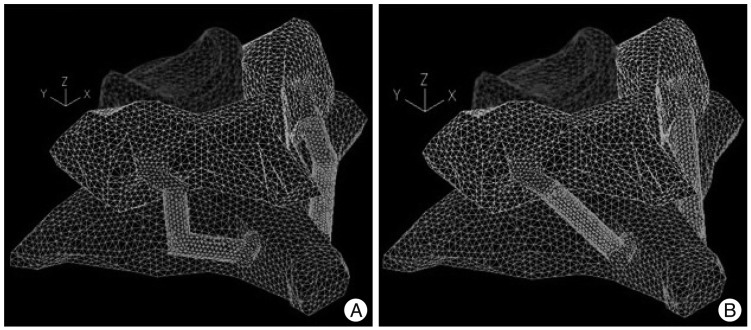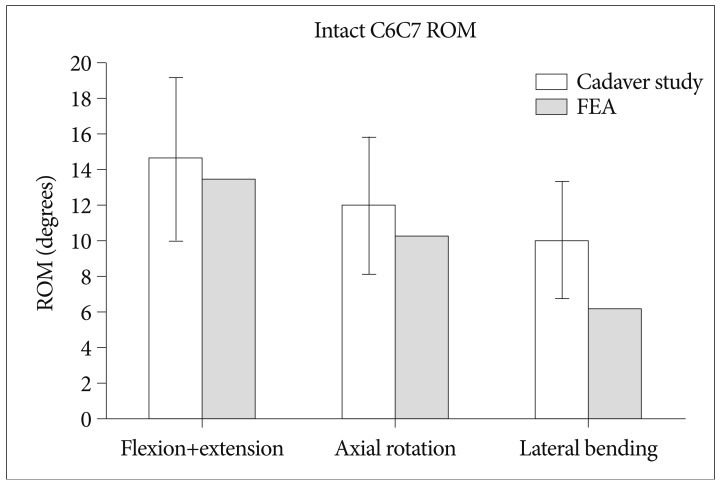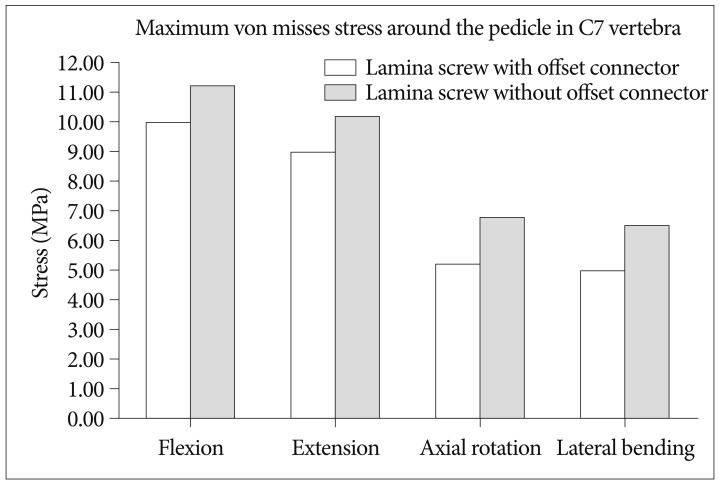J Korean Neurosurg Soc.
2013 Jun;53(6):331-336. 10.3340/jkns.2013.53.6.331.
A Biomechanical Comparison of Intralaminar C7 Screw Constructs with and without Offset Connector Used for C6-7 Cervical Spine Immobilization : A Finite Element Study
- Affiliations
-
- 1Department of Orthopedic Surgery, Rush University Medical Center, Chicago, IL, USA. jatagi15@gmail.com
- 2Department of Neurosurgery, The Catholic University of Korea, St. Vincent's Hospital, Suwon, Korea.
- 3Department of Bioengineering, University of Illinois at Chicago, Chicago, IL, USA.
- KMID: 2190819
- DOI: http://doi.org/10.3340/jkns.2013.53.6.331
Abstract
OBJECTIVE
The offset connector can allow medial and lateral variability and facilitate intralaminar screw incorporation into the construct. The aim of this study was to compare the biomechanical characteristics of C7 intralaminar screw constructs with and without offset connector using a three dimensional finite element model of a C6-7 cervical spine segment.
METHODS
Finite element models representing C7 intralaminar screw constructs with and without the offset connector were developed. Range of motion (ROM) and maximum von Mises stresses in the vertebra for the two techniques were compared under pure moments in flexion, extension, lateral bending and axial rotation.
RESULTS
ROM for intralaminar screw construct with offset connector was less than the construct without the offset connector in the three principal directions. The maximum von Misses stress was observed in the C7 vertebra around the pedicle in both constructs. Maximum von Mises stress in the construct without offset connector was found to be 12-30% higher than the corresponding stresses in the construct with offset connector in the three principal directions.
CONCLUSION
This study demonstrated that the intralaminar screw fixation with offset connector is better than the construct without offset connector in terms of biomechanical stability. Construct with the offset connector reduces the ROM of C6-7 segment more significantly compared to the construct without the offset connector and causes lower stresses around the C7 pedicle-vertebral body complex.
Figure
Reference
-
1. Abumi K, Ito M, Kaneda K. Surgical treatment of cervical destructive spondyloarthropathy (DSA). Spine (Phila Pa 1976). 2000; 25:2899–2905. PMID: 11074677.
Article2. Arand M, Kinzl L, Gebhard F. [Sources of error and risks in CT based navigation]. Orthopade. 2002; 31:378–384. PMID: 12056279.3. Argoubi M, Shirazi-Adl A. Poroelastic creep response analysis of a lumbar motion segment in compression. J Biomech. 1996; 29:1331–1339. PMID: 8884478.
Article4. Barrey C, Cotton F, Jund J, Mertens P, Perrin G. Transpedicular screwing of the seventh cervical vertebra : anatomical considerations and surgical technique. Surg Radiol Anat. 2003; 25:354–360. PMID: 12955478.
Article5. Bozkus H, Ames CP, Chamberlain RH, Nottmeier EW, Sonntag VK, Papadopoulos SM, et al. Biomechanical analysis of rigid stabilization techniques for three-column injury in the lower cervical spine. Spine (Phila Pa 1976). 2005; 30:915–922. PMID: 15834336.
Article6. Clausen JD, Goel VK, Traynelis VC, Scifert J. Uncinate processes and Luschka joints influence the biomechanics of the cervical spine : quantification using a finite element model of the C5-C6 segment. J Orthop Res. 1997; 15:342–347. PMID: 9246079.
Article7. Ebraheim NA, Tremains M, Xu R, Yeasting RA. Anatomic study of the cervicothoracic spinal nerves and their relation to the pedicles. Am J Orthop (Belle Mead NJ). 2000; 29:779–781. PMID: 11043961.8. Holly LT, Foley KT. Percutaneous placement of posterior cervical screws using three-dimensional fluoroscopy. Spine (Phila Pa 1976). 2006; 31:536–540. discussion 541. PMID: 16508547.
Article9. Hong JT, Sung JH, Son BC, Lee SW, Park CK. Significance of laminar screw fixation in the subaxial cervical spine. Spine (Phila Pa 1976). 2008; 33:1739–1743. PMID: 18628706.
Article10. Hong JT, Tomoyuki T, Udayakumar R, Espinoza Orías AA, Inoue N, An HS. Biomechanical comparison of three different types of C7 fixation techniques. Spine (Phila Pa 1976). 2011; 36:393–398. PMID: 21325933.
Article11. Hong JT, Yi JS, Kim JT, Ji C, Ryu KS, Park CK. Clinical and radiologic outcome of laminar screw at C2 and C7 for posterior instrumentation--review of 25 cases and comparison of C2 and C7 intralaminar screw fixation. World Neurosurg. 2010; 73:112–118. discussion e15. PMID: 20860937.
Article12. Hussain M, Natarajan RN, Chaudhary G, An HS, Andersson GB. Relative contributions of strain-dependent permeability and fixed charged density of proteoglycans in predicting cervical disc biomechanics : a poroelastic C5-C6 finite element model study. Med Eng Phys. 2011; 33:438–445. PMID: 21167763.
Article13. Jang SH, Hong JT, Kim IS, Yeo IS, Son BC, Lee SW. C7 posterior fixation using intralaminar screws : early clinical and radiographic outcome. J Korean Neurosurg Soc. 2010; 48:129–133. PMID: 20856661.
Article14. Johnston TL, Karaikovic EE, Lautenschlager EP, Marcu D. Cervical pedicle screws vs. lateral mass screws : uniplanar fatigue analysis and residual pullout strengths. Spine J. 2006; 6:667–672. PMID: 17088197.
Article15. Kamimura M, Ebara S, Itoh H, Tateiwa Y, Kinoshita T, Takaoka K. Cervical pedicle screw insertion : assessment of safety and accuracy with computer-assisted image guidance. J Spinal Disord. 2000; 13:218–224. PMID: 10872759.
Article16. Karaikovic EE, Yingsakmongkol W, Gaines RW Jr. Accuracy of cervical pedicle screw placement using the funnel technique. Spine (Phila Pa 1976). 2001; 26:2456–2462. PMID: 11707710.
Article17. Kim HS, Heller JG, Hudgins PA, Fountain JA. The accuracy of computed tomography in assessing cervical pedicle screw placement. Spine (Phila Pa 1976). 2003; 28:2441–2446. PMID: 14595161.
Article18. Kothe R, Rüther W, Schneider E, Linke B. Biomechanical analysis of transpedicular screw fixation in the subaxial cervical spine. Spine (Phila Pa 1976). 2004; 29:1869–1875. PMID: 15534407.
Article19. Kretzer RM, Sciubba DM, Bagley CA, Wolinsky JP, Gokaslan ZL, Garonzik IM. Translaminar screw fixation in the upper thoracic spine. J Neurosurg Spine. 2006; 5:527–533. PMID: 17176017.
Article20. Kumaresan S, Yoganandan N, Pintar FA. Finite element modeling approaches of human cervical spine facet joint capsule. J Biomech. 1998; 31:371–376. PMID: 9672091.
Article21. Kumaresan S, Yoganandan N, Pintar FA, Macias M, Cusick JF. Morphology of young and old cervical spine intervertebral disc tissues. Biomed Sci Instrum. 2000; 36:141–146. PMID: 10834223.22. Lee CK, Kim YE, Lee CS, Hong YM, Jung JM, Goel VK. Impact response of the intervertebral disc in a finite-element model. Spine (Phila Pa 1976). 2000; 25:2431–2439. PMID: 11013493.
Article23. Mazel C, Hoffmann E, Antonietti P, Grunenwald D, Henry M, Williams J. Posterior cervicothoracic instrumentation in spine tumors. Spine (Phila Pa 1976). 2004; 29:1246–1253. PMID: 15167665.
Article24. Miller RM, Ebraheim NA, Xu R, Yeasting RA. Anatomic consideration of transpedicular screw placement in the cervical spine. An analysis of two approaches. Spine (Phila Pa 1976). 1996; 21:2317–2322. PMID: 8915065.
Article25. Nissan M, Gilad I. The cervical and lumbar vertebrae--an anthropometric model. Eng Med. 1984; 13:111–114. PMID: 6542880.26. Panjabi MM, Duranceau J, Goel V, Oxland T, Takata K. Cervical human vertebrae. Quantitative three-dimensional anatomy of the middle and lower regions. Spine (Phila Pa 1976). 1991; 16:861–869. PMID: 1948369.
Article27. Panjabi MM, Oxland TR, Parks EH. Quantitative anatomy of cervical spine ligaments. Part II. Middle and lower cervical spine. J Spinal Disord. 1991; 4:277–285. PMID: 1802158.
Article28. Papagelopoulos PJ, Currier BL, Neale PG, Hokari Y, Berglund LJ, Larson DR, et al. Biomechanical evaluation of posterior screw fixation in cadaveric cervical spines. Clin Orthop Relat Res. 2003; 13–24. PMID: 12782855.
Article29. Rath SA, Moszko S, Schäffner PM, Cantone G, Braun V, Richter HP, et al. Accuracy of pedicle screw insertion in the cervical spine for internal fixation using frameless stereotactic guidance. J Neurosurg Spine. 2008; 8:237–245. PMID: 18312075.
Article30. Reinhold M, Magerl F, Rieger M, Blauth M. Cervical pedicle screw placement : feasibility and accuracy of two new insertion techniques based on morphometric data. Eur Spine J. 2007; 16:47–56. PMID: 16628443.
Article31. Rhee JM, Kraiwattanapong C, Hutton WC. A comparison of pedicle and lateral mass screw construct stiffnesses at the cervicothoracic junction : a biomechanical study. Spine (Phila Pa 1976). 2005; 30:E636–E640. PMID: 16261101.32. Schmidt R, Wilke HJ, Claes L, Puhl W, Richter M. Effect of constrained posterior screw and rod systems for primary stability : biomechanical in vitro comparison of various instrumentations in a single-level corpectomy model. Eur Spine J. 2005; 14:372–380. PMID: 15248055.
Article33. Skrzypiec DM, Pollintine P, Przybyla A, Dolan P, Adams MA. The internal mechanical properties of cervical intervertebral discs as revealed by stress profilometry. Eur Spine J. 2007; 16:1701–1709. PMID: 17671801.
Article34. Teo EC, Ng HW. Evaluation of the role of ligaments, facets and disc nucleus in lower cervical spine under compression and sagittal moments using finite element method. Med Eng Phys. 2001; 23:155–164. PMID: 11410380.
Article35. Vasavada AN, Danaraj J, Siegmund GP. Head and neck anthropometry, vertebral geometry and neck strength in height-matched men and women. J Biomech. 2008; 41:114–121. PMID: 17706225.
Article36. Wang MY. Cervical crossing laminar screws : early clinical results and complications. Neurosurgery. 2007; 61(5 Suppl 2):311–315. discussion 315-316. PMID: 18091245.37. Wright NM. Posterior C2 fixation using bilateral, crossing C2 laminar screws : case series and technical note. J Spinal Disord Tech. 2004; 17:158–162. PMID: 15260101.
- Full Text Links
- Actions
-
Cited
- CITED
-
- Close
- Share
- Similar articles
-
- C7 Posterior Fixation Using Intralaminar Screws : Early Clinical and Radiographic Outcome
- Biomechanical Analysis of 3-Level Anterior Cervical Discectomy and Fusion Under Physiologic Loads Using a Finite Element Model
- Biomechanical Study on Three Screw-Based Atlantoaxial Fixation Techniques: A Finite Element Study
- Analysis of Biomechanical Properties of Whole Cervical Spine under Static Loading with 3-D Finite Element Model
- Biomechanical Comparison of Spinal Fusion Methods Using Interspinous Process Compressor and Pedicle Screw Fixation System Based on Finite Element Method






